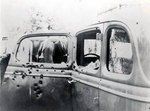FLYBOYJ,
The authors do state that the Soviet pilots greatly overclaimed, but they also repeat the claim that the Americans intentionally understated their losses. Not that I'm an expert, but I do not beleive there's any evidence for that.
Other historical aerial combats that are given in the book, such as Mig 15 cold war interceptions and Egyptian Mig 15 operations, do conform to generally accepted facts. All in all it's an excellent book.
The authors do state that the Soviet pilots greatly overclaimed, but they also repeat the claim that the Americans intentionally understated their losses. Not that I'm an expert, but I do not beleive there's any evidence for that.
Other historical aerial combats that are given in the book, such as Mig 15 cold war interceptions and Egyptian Mig 15 operations, do conform to generally accepted facts. All in all it's an excellent book.


